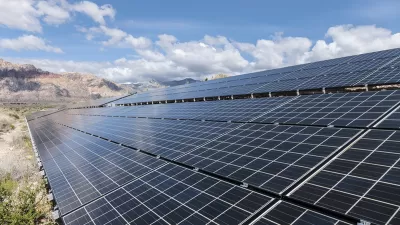The sixth-largest self-storage company in the United States will add solar panels to 8.5 million square feet of its facilities’ rooftops to produce community solar power.

Self-storage powerhouse National Storage Affiliates Trust, in partnership with community solar developer Solar Landscape, is set to add solar panels to 8.5 million square feet of its rooftop space, according to an article from Electrek. “That’s enough solar panels to cover roughly 1,000 of NSA’s self-storage properties scattered across 42 states and Puerto Rico,” and is equal to 100 megawatts of solar capacity to power not just NSA facilities but also nearby homes and businesses. And thanks to the community solar model, the energy will be discounted, reports Michelle Lewis. “This setup means energy gets produced right where it’s needed, reducing strain on the grid and cutting down on energy costs for locals.”
As part of the partnership, NSA will lease Solar Landscape its rooftop space, while Solar Landscape will develop, own, and operate the solar systems. According to the article, the first sites are already under development. In another Electrek article from last year, Lewis reported that industrial rooftops are prime candidates for solar panel space; the U.S. has more than 450,000 warehouses and distribution centers offering up more than 16.4 billion of roof area. “[T]he rooftops of US warehouses built before 2019 alone have the potential to generate 185.6 terawatt-hours (TWh) of solar electricity annually – enough to power 19.4 million average households. That’s equivalent to roughly the entire New York-Newark-Jersey City metropolitan area,” according to the 2023 article.
Given concerns about solar farms taking valuable farmland out of production, turning to large-footprint industrial rooftops to host panels could certainly be a promising alternative.
FULL STORY: 8.5M square feet of US self-storage rooftops are getting solar

Planetizen Federal Action Tracker
A weekly monitor of how Trump’s orders and actions are impacting planners and planning in America.

San Francisco's School District Spent $105M To Build Affordable Housing for Teachers — And That's Just the Beginning
SFUSD joins a growing list of school districts using their land holdings to address housing affordability challenges faced by their own employees.

The Tiny, Adorable $7,000 Car Turning Japan Onto EVs
The single seat Mibot charges from a regular plug as quickly as an iPad, and is about half the price of an average EV.

With Protected Lanes, 460% More People Commute by Bike
For those needing more ammo, more data proving what we already knew is here.

In More Metros Than You’d Think, Suburbs are Now More Expensive Than the City
If you're moving to the burbs to save on square footage, data shows you should think again.

The States Losing Rural Delivery Rooms at an Alarming Pace
In some states, as few as 9% of rural hospitals still deliver babies. As a result, rising pre-term births, no adequate pre-term care and "harrowing" close calls are a growing reality.
Urban Design for Planners 1: Software Tools
This six-course series explores essential urban design concepts using open source software and equips planners with the tools they need to participate fully in the urban design process.
Planning for Universal Design
Learn the tools for implementing Universal Design in planning regulations.
Smith Gee Studio
City of Charlotte
City of Camden Redevelopment Agency
City of Astoria
Transportation Research & Education Center (TREC) at Portland State University
US High Speed Rail Association
City of Camden Redevelopment Agency
Municipality of Princeton (NJ)





























